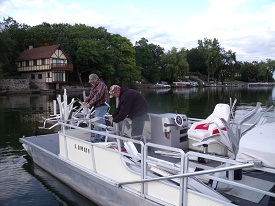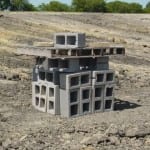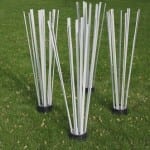 |
| Published 17th Nov 2011 |
| http://www.youtube.com/watch?v=a15veu8Onlg&feature=player_embedded Members of the Sportsman’s club are at it again, enhancing their lake with more long term habitat, teamed up with Fishiding, 56 units of all varieties were dropped in a key area adjacent to spawning grounds. About 10 shallow Cradle models were sunk in 3-5 feet of water, with a line of Safehouse structures leading out to deeper water. The Cradle model consists of hundreds of fine strands of reclaimed PVC designed to give fry and baitfish areas to grow and hide from predators. When the fry have adequate habitat, they are given time to grow to the preferred size of 4-6 inches before venturing out into deeper water to become forage for predators.See the dozens of unique artificial fish habitat models, fish attractors and fish cover used at fishiding.com, the industry leader and only science based, man made and artificial fish habitat, proven to provide all fish with cover they prefer to prosper. The key is to make sure there is a continuous line or “tree row” of habitat from shallow spawning grounds out to deep water. If the fish have to swim from shallow areas out to deeper cover without cover to hide in, they get eaten prematurely, or before growing large enough to best benefit the larger predators like bass, walleye, crappie and musky. The club members clipped structurespot markers to each unit as it was dropped, to see where each one lands to ensure the continuous coverage. When all units are installed, they took some pictures to refer to the shape and design they created. After the pics, they simply pull the clip free on the structurespot markers and wind them up to re-use. The Safehouse models were installed from about 5 feet deep out to 8 feet and deeper where a huge cluster of the largest Keeper models were dropped. Algae begins to grow immediately in this dark, fertile water and the club will be fishing over them this winter through the ice. To date, over 125 fishiding fish habitatunits have been installed, with more being put together by members, donated by fishiding. Wonder Lake, at 830 acres, is the largest private lake in Illinois and Wisconsin. Through many different fund raising events, the club stocks fish twice a year as well as building and installing over 100 Wood duck houses, maintaining them and even video recording the hatching of chicks too. Annual lake cleanups, fish shocking surveys, carp derbys and kids fishing events are just a few of the things the club does for the lake and the community. |
Category: FISH ATTRACTOR PROJECTS
Ranch improves fishing opportunities and Brush Creek
See the dozens of unique artificial fish habitat models, fish attractors and fish cover used at fishiding.com, the industry leader and only science based, man made and artificial fish habitat, proven to provide all fish with cover they prefer to prosper.
NOAA Receives $4.8 Million to Restore Habitat in Great Lakes Area of Concern
NOAA announced today that it has awarded nearly $5 million to eight projects to support habitat restoration throughout the Great Lakes Areas of Concern. NOAA’s Restoration Center is funding Continue reading “NOAA Receives $4.8 Million to Restore Habitat in Great Lakes Area of Concern”
Ohio Division of Wildlife sinks some spools to create fish attractors
Sinking Spools for Shoreline Succes
Division’s work aims to help shore anglers
 This past week, the Ohio Division of Wildlife placed fish attractors in a popular shore fishing spot atMosquito Reservoir (Trumbull County). “From ice out to ice up, there’s always someone fishing along that stretch of shoreline. We hope our work will improve the fishing along there,” said Matt Wolfe, Fisheries Biologist, who oversees this project for the Ohio Division of Wildlife. Plastic spools weighed down with stone were placed near the rip-rap break wall outside of the State Park Boat launch on the south side of the lake. Spools were placed along the outside and inside edges of both the Northern and Southern sections of the break wall. In total, 50 spools were placed in anywhere from seven to 14-feet of water. More importantly though, “the spools were placed within easy casting distance for anglers who fish this area,” added Wolfe.
This past week, the Ohio Division of Wildlife placed fish attractors in a popular shore fishing spot atMosquito Reservoir (Trumbull County). “From ice out to ice up, there’s always someone fishing along that stretch of shoreline. We hope our work will improve the fishing along there,” said Matt Wolfe, Fisheries Biologist, who oversees this project for the Ohio Division of Wildlife. Plastic spools weighed down with stone were placed near the rip-rap break wall outside of the State Park Boat launch on the south side of the lake. Spools were placed along the outside and inside edges of both the Northern and Southern sections of the break wall. In total, 50 spools were placed in anywhere from seven to 14-feet of water. More importantly though, “the spools were placed within easy casting distance for anglers who fish this area,” added Wolfe.The “tree army” installs wooden spawn boxes for fish

The US Army Corps of Engineers will host National Public Lands Day events at various lakes throughout the Pittsburgh District. In 2010, more than 500 volunteers came to 15 of 16 Pittsburgh District recreation projects and provided 2,179 hours of work valued at nearly $47,000. National Public Lands Day keeps the promise of the Civilian Conservation Corps, the “tree army” that worked from 1933-1942 to preserve and protect America’s natural heritage.
A local event at Mahoning Creek Lake will be held Sept. 24. This year the goal is to accomplish the building and placement of some fish habitat spawning boxes in the lake. If time permits, shore line clean-up will be done. Volunteers are asked to meet at 9:30 a.m. at the Milton Loop Campground pavilion, on Route 839, two miles north of Dayton.
See the dozens of unique artificial fish habitat models, fish attractors and fish cover used at fishiding.com, the industry leader and only science based, man made and artificial fish habitat, proven to provide all fish with cover they prefer to prosper.
The project will be to build wooden spawn boxes and then taking them by boat to place them in the lake. Event will take place rain or shine. Questions may be directed to Park Ranger Grover Pegg 412-719-9227.
Arizona fish habitat video for Apache lake
See what work is being done on a large scale in Arizona in the name of fish habitat.
See the dozens of unique artificial fish habitat models, fish attractors and fish cover used at fishiding.com, the industry leader and only science based, man made and artificial fish habitat, proven to provide all fish with cover they prefer to prosper.
Climate Change May Drive Native Fish from Wis. Waters
Young Girls build fish habitat at Smith Mountain Lake State Park
 |
| Smith Mountain Lake State Park ranger, John Mitchell, above, inspects the first trailer load of fish habitat blocks to leave the park’s public boat landing Wednesday for their permanent locations at the 15-foot deep level of the Lake. Constructed of polyethylene piping, cinder blocks and concrete, the habitats resemble submerged tree limbs to fish, providing cover from predators, as well as places to rest and raise young. Youth Conservation Corps members, who left the park Saturday for home, constructed the habitats, some 150 of which were distributed in the Lake last week. |
One hundred and fifty handmadefish habitats-looking very much like an army of extraterrestrials having a wild hair day–marched in stiff formation down a pier early Wednesday at Smith Mountain Lake State Park, tentacles of black polyethylene pipe crowning their heads and concrete-filled cinder blocks acting as footing.
See the dozens of unique artificial fish habitat models, fish attractors and fish cover used at fishiding.com, the industry leader and only science based, man made and artificial fish habitat, proven to provide all fish with cover they prefer to prosper.
Eight Youth Conservation Corps (YCC) high school crew members, three college-age YYC supervisors and John Mitchell, a ranger at the park, worked in tandem, transferring the soon-to-be-sunken assemblages from a flatbed trailer to the dock, then onto boats for distribution in the Lake. Their loads in place, boats piloted by rangers and filled with teens andfish houses sluiced through the water to various destinations, among them Smith Mountain Lake Community Park, across the main channel and within sight of the launching point at the State Park’s public boat ramp, docks at the park’s Discovery Center and beach, and possibly by some of the park’s lakefront housekeeping cabins if the crew didn’t run out.
Arriving at the park on July 25, the all-female YYC crew also constructed eight picnic pads.
“They dug out the sites level, fitted them with 4′ x 6′ timbers, then filled them with stone,” said Mitchell.
It took the crew almost two days to make the fish habitats in a design and with materials recommended by the Virginia Dept. and Game and Inland Fisheries.
“The girls have done a great job,” said Brian Heft, Smith Mountain Lake State Park manager. “This is something we’ve done for years to support fish structure in the Lake. Fish need assistance to hide from predators, rear their young, and rest. Docks are not necessarily fish structure. Structures come up from the bottom of the Lake. This is an ongoing process. We plan on continuing it.” REBECCA JACKSON
Oregon needs fish habitat
Fish habitat project planned on Beaver Creek is combined effortPosted: Wednesday, Aug 3rd, 2011
This month, the Oregon Department of Fish and Wildlife and the Lincoln Soil and Water Conservation District will place 60 Continue reading “Oregon needs fish habitat” | ||||||||||
Fish habitat projects planned at High Point, Lake Somerset
 Ken Coughenour of Somerset casts a white twister in hopes of hooking “a big bass” at Lake Somerset on Monday. (Staff photo by Roger Vogel) Ken Coughenour of Somerset casts a white twister in hopes of hooking “a big bass” at Lake Somerset on Monday. (Staff photo by Roger Vogel) |
12:36 a.m. EDT, July 19, 2011
Last year’s work at High Point Lake proved popular with area fishermen and sportsmen. There were requests for an additional project at Lake Somerset. This spring the Somerset County Sportsmen’s League also entered into an agreement with the PFBC to begin a similar project at Lake Somerset. Representatives from the PFBC Lake Habitat Section and sportsmen’s league created a plan for Lake Somerset this past April.
On Aug. 20 volunteers are asked to meet at 9 a.m. at the rear of the PFBC Southwest Regional Office at Lake Somerset. The plan that day is to construct 20 porcupine crib juniors for fish habitat. They will also be built on shore and then placed at suitable locations in the lake by special boat.
Lake Somerset is a 248-acre impoundment managed by the PFBC. It is also a highly popular fishing spot. Among the most popular species in the lake are largemouth bass, walleye, northern pike, muskellunge, channel catfish, crappies and bluegills.
Volunteers who wish to help with either project may notify Don Anderson, contact person for the sportsmen’s league, at 814-634-0998.
 ENLARGE
ENLARGE

